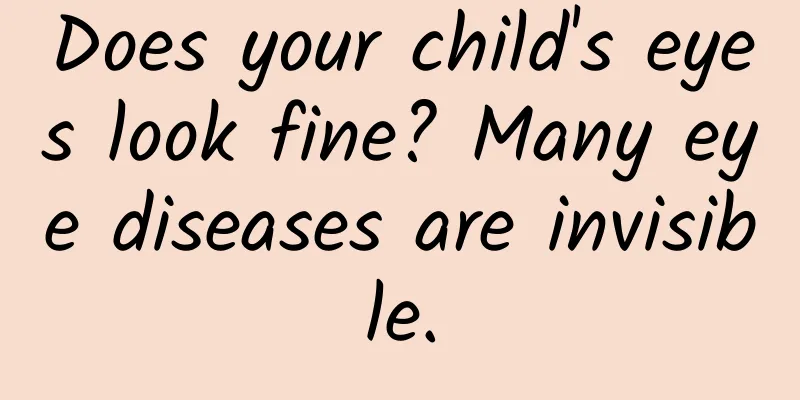Does your child's eyes look fine? Many eye diseases are invisible.

|
"My child's eyes are fine, why should I take him/her to the hospital?" Many parents think this way. After reading this article, your understanding may change, and the benefits may exceed your imagination. Although the eyeball is small, not even as big as a ping-pong ball, do you know how many eye-related diseases there are? According to the International Classification of Diseases (ICD-10), there are 823 eye-related diseases, most of which children will also suffer from. Many eye diseases may not have any obvious symptoms in the early stages, so they are ignored by parents, and they are not diagnosed and treated early, which delays the treatment of children. Dr. Jingcai has selected eye diseases that children of all ages need parents to pay attention to, and will introduce them to you: What “invisible” eye diseases may exist in children aged 0 to 3 years old? Children of this age have limited cognitive and expressive abilities, and many eye problems are not easily discovered by their parents. - Retinoblastoma . The most common malignant eye tumor in children, 90% of which occurs before the age of 3. The incidence rate is not high, about 1:20,000 (one in 20,000), but the consequences are serious and can even lead to the death of the child. This disease usually occurs in one eye. If parents are careful, they can observe that the pupil of one side of the child will reflect a yellow-white reflection under the light, which is very different from the other eye. At this time, they should seek medical attention immediately. A more proactive approach is to perform fundus examinations after the child is born and every year thereafter to detect it as early as possible. - Congenital cataracts . Cataracts are not exclusive to the elderly. Some children are born with them, and some are even very serious. The incidence rate in China is about 0.05%. This disease is painless and itchy. Children are young, so it is difficult for parents to detect it without going to the hospital for examination. Severe cataracts can cause blindness, and for infants and young children, it can also affect the normal development of visual function, which is very serious. -Neonatal dacryocystitis . The incidence rate is about 6% in newborns. It usually manifests as tearing, increased eye secretions, redness and swelling below the inner corner of the eye (where the lacrimal sac is located), etc. If it is not serious, the above symptoms may not be obvious and may be easily ignored by careless parents, thus becoming more serious and even complicated by serious corneal infection. - Refractive issues . Children of this age are still in the development stage of their eyes and vision. Normally, they are in a state of "physiological hyperopia". However, some children will have astigmatism or even develop myopia early. In this case, if parents do not take their children for a check-up, the children will not tell you - the children think that the blurry world in their eyes is normal because they are used to it, and parents cannot see what the world looks like in their children's eyes. If astigmatism and myopia are not corrected, they will develop into amblyopia over time. - Amblyopia . There is no organic lesion in the eye, but even if the refractive error is corrected as much as possible with glasses, the child's vision still cannot reach normal vision for the corresponding age group. - Glaucoma . Yes, even such a young child can get glaucoma. It is usually a congenital developmental problem. The child's intraocular pressure is higher than that of normal children. However, children of this age may not be able to express it, but often cry. Parents do not have professional knowledge and often cannot see any abnormalities in the appearance of the eyes. Severe glaucoma can cause blindness. What should we pay attention to for children aged 3 to 6? - The aforementioned refraction-related and amblyopia problems still need to be taken seriously . It’s just that children of this age have stronger communication skills and may tell their parents if they can’t see clearly. But parents should still take the initiative to take their children for a checkup once a year. - Starting from the age of 3, parents should help their children establish a refractive development file, recording the child's vision, refractive power, axial length and other indicators checked every year or every six months, until the child is 14 or even 18 years old. This data is very valuable and allows parents to cooperate with doctors to jointly judge the child's refractive development. The refractive file function of Tejingcai is simple and easy to use, you can try it. -Dry eyes . The incidence of dry eyes in children is not low. If you find that your child frequently blinks or rubs his eyes, even if there is no abnormality in the eyes, you should take your child to see a doctor in time. Severe dry eyes can affect the health of the corneal epithelium and even cause keratitis. -In addition, this age group is also an important stage for cultivating children's eye habits . Try to maintain sufficient outdoor light activity time every day, reduce close-range eye use, and prevent myopia. What about over 6 years old? When I was in primary school, myopia was my biggest enemy: - If the child has not yet developed myopia, he or she should be examined once a year, paying attention to the child's hyperopia reserve, naked eye vision, axial length and other indicators; - If your child has already developed myopia, please listen to the advice of ophthalmologists and optometrists to see if it is necessary to take relevant measures to control myopia (including OK lenses, multifocal soft lenses, specially designed frame lenses, low-concentration atropine eye drops, etc.), rather than just taking your child to get glasses on your own initiative; In summary, children of all ages have noteworthy and "invisible" eye diseases, and parents must be on guard. However, it is impossible for parents to know everything about eye diseases. The simplest way is to take your child to an ophthalmology hospital or optometry clinic for a comprehensive eye health check every six months, or at least once a year. 90% of human perception of the external world depends on vision, so it is completely worth doing so. If your child has not been to the ophthalmology or optometry clinic for a year or more, please take action now. If you find this article helpful, you are welcome to forward it to other parents. Dr. Eye Color believes that it will definitely help them. For more ophthalmology related knowledge, you can follow Tejingcai About Dr. Jingcai: The creators of Dr. Jingcai's popular science content all have a professional background in ophthalmology, a master's degree or above, and are former ophthalmologists. For some popular science content with a higher degree of professionalism, we will also invite working ophthalmologists and optometry experts to review and check it, striving to be responsible for the accuracy of the content and avoid misleading readers. |
<<: Basic knowledge about myopia
>>: Interesting Medicine Talk | Salmon Calcitonin (with audio)
Recommend
Did you know that knee injuries are the killer?
As the concept of Healthy China continues to deep...
What is the reason for bleeding during menstruation?
Every woman has a few days every month when menst...
How to prevent stretch marks on pregnant women's belly
Pregnancy is the happiest thing in a woman’s life...
How to make wolfberry rose tea
Wolfberry is a small fruit that makes us feel bea...
What are the symptoms of uterine cold?
For female friends, the phenomenon of uterine col...
What is the image of Cao Cao in the Romance of the Three Kingdoms? How did Cao Chong die in the Romance of the Three Kingdoms?
There are more than a thousand characters with na...
Why does a girl feel pain and swelling down there?
The female genitals are not only very sensitive, ...
How to monitor follicle release
Monitoring follicle discharge is very important f...
How does the "fat drama" in the body affect our health?
Have you ever thought that there are wonderful &q...
Guerlain Restoring Honey Review
Guerlain is really suitable for those who are obs...
Eight symptoms of a woman's lack of energy
It is quite common in life that women lack energy...
World Earth Day | Microplastics in disposable tableware, can I eat less?
"Recently, the New England Journal of Medici...
Can breast hyperplasia be cured by massage?
Although breast hyperplasia may not seem serious,...
Symptoms of cervical moistness
From a medical point of view, women over the age ...
Why is my period still not over after seven days?
Generally speaking, although menstruation brings ...









